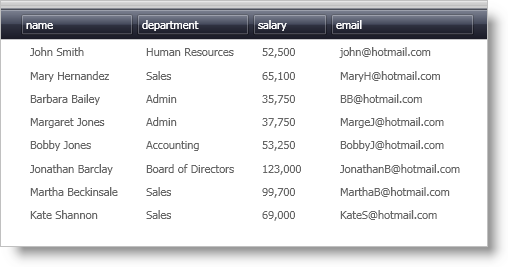<Grid Name="layoutRoot">
</Grid>This topic shows you how to create and add a xamDataPresenter™ control to your Window using procedural code.
Create a Microsoft® Windows® Presentation Foundation Window project.
In the Solution Explorer, add the following references:
InfragisticsWPF.dll
InfragisticsWPF.Editors.dll
InfragisticsWPF.DataPresenter.dll
Name the default Grid layout panel so that you can reference it in the code-behind.
In XAML:
<Grid Name="layoutRoot">
</Grid>Attach an event handler to the Window’s Loaded event if you are going to use the code-behind to add the xamDataPresenter.
In XAML:
<Window ... Loaded="Window_Loaded" ... >Add a namespace declaration and using/Imports directives for xamDataPresenter.
In XAML:
xmlns:igDP="http://infragistics.com/DataPresenter"In Visual Basic:
Imports Infragistics.Windows.DataPresenterIn C#:
using Infragistics.Windows.DataPresenter;Create an instance of xamDataPresenter in XAML or in the Window_Loaded event handler in code-behind. Set the BindToSampleData property to True. This will automatically populate xamDataPresenter with sample data so that you can preview the xamDataPresenter control without setting up a data source.
In XAML:
<igDP:XamDataPresenter Name="xamDataPresenter1" BindToSampleData="True" />In Visual Basic:
Private xamDataPresenter1 as XamDataPresenter
xamDataPresenter1 = New XamDataPresenter()
' You can data bind your instance of xamDataPresenter
' instead of using the built in sample data
xamDataPresenter1.BindToSampleData = True
Me.layoutRoot.Children.Add(xamDataPresenter1)In C#:
private XamDataPresenter xamDataPresenter1;
xamDataPresenter1 = new XamDataPresenter();
// You can data bind your instance of xamDataPresenter
// instead of using the built in sample data
xamDataPresenter1.BindToSampleData = true;
this.layoutRoot.Children.Add(xamDataPresenter1);Run the project to see the xamDataPresenter control populated with sample data.
